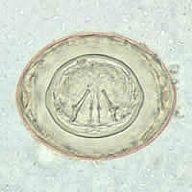![]()
![]()
![]()
Use LEFT and RIGHT arrow keys to navigate between flashcards;
Use UP and DOWN arrow keys to flip the card;
H to show hint;
A reads text to speech;
25 Cards in this Set
- Front
- Back
|
Know the following information for each parasitic species:
Any unique characteristics which separates it from the others Associate the name of the disease with the genus and species of parasite Associate diagnostic and infectious stages of each parasite with the disease name and organism that causes the condition (including images of the parasites) Use special structural features to aid your association of organism and disease (operculum for example) and note any special diagnostic procedures for parasite identification Associate the method of infection with each parasite name and disease Be able to define terms such as trophozoite and cyst. |
obj
|
|
|
Cestoda – Hymenolepis nana
(_____ Tapeworm) |
Cestoda – Hymenolepis nana
(Dwarf Tapeworm) |
|
|
How do you diagnose (Cestoda) – Hymenolepis nana
(Dwarf Tapeworm) |

Recovery of eggs in feces
|
|
|
What is therapy for Hymenolepis nana
(Dwarf Tapeworm) |
Praziquantel and Niclosamide
|
|
|
Cestoda – Taenia saginata (____ Tapeworm) & Taenia solium (____ Tapeworm)
|
Cestoda – Taenia saginata (Beef Tapeworm) & Taenia solium (Pork Tapeworm)
|
|
|
Taenia saginata (____ Tapeworm) & Taenia solium (____ Tapeworm)
Human infection results from eating beef or pork that have o__________ in cysticerci in their muscles |
Taenia saginata (____ Tapeworm) & Taenia solium (____ Tapeworm)
Human infection results from eating beef or pork that have oncospheres in cysticerci in their muscles |
|
|
What is the official name for the head of Taenia saginata?
|
scolex
|
|
|
Cestoda – Taenia solium (Cysticercosis)
Cysticercosis develops if cysticerci are eaten and develop in subQ tissues, brain and/or eye. |
Cestoda – Taenia solium (Cysticercosis)
Cysticercosis develops if cysticerci are eaten and develop in subQ tissues, _____ and/or ___. |
|
|
Humans may pass Taenia saginata (Beef Tapeworm) & Taenia solium (Pork Tapeworm)
eggs or gravid p__________ in their feces |
Humans may pass Taenia saginata (Beef Tapeworm) & Taenia solium (Pork Tapeworm)
eggs or gravid proglottids in their feces |
|
|
How do you diagnose?
Cestoda – Taenia saginata (Beef Tapeworm) & Taenia solium (Pork Tapeworm) |
Recovery of eggs or gravid proglottid in feces. ELISA used for diagnosis of cysticercosis.
Female can lay up to 60,000-600,000 eggs per day! |
|
|
therapy for beef/pork tapeworm
|
Adult tapeworm: Niclosamide
- Cysticercosis: Praziquantel, anticonvulsants for seizures and surgery. |
|
|
T. saginata found in ____________ US while T. solium is rare in the US.
|
T. saginata found in southwestern US while T. solium is rare in the US.
|
|
|
Hymenolepis nana
(Dwarf Tapeworm) Most common tapeworm infection in the US; most prevalent in __________. |
Hymenolepis nana
(Dwarf Tapeworm) Most common tapeworm infection in the US; most prevalent in Southeast. |
|
|
Cestoda – Diphyllobothrium latum
(_________ Tapeworm) |
Cestoda – Diphyllobothrium latum
(Broadfish Tapeworm) |
|
|
Cestoda – Diphyllobothrium latum
(Broadfish Tapeworm) the eggs become coracidia and are eaten by crustaceans. The coracidia ___cercoid larvae become _____cercoid larvae after crustacean is eaten by a fish (freshwater). Then, a human eats the fish |
Cestoda – Diphyllobothrium latum
(Broadfish Tapeworm) the eggs become coracidia and are eaten by crustaceans. The coracidia Procercoid larvae become plerocercoid larvae after crustacean is eaten by a fish (freshwater). Then, a human eats the fish |
|
|
How do you diagnose Diphyllobothrium latum
(Broadfish Tapeworm) ? |
Recovery of eggs in feces.
Adult worms can grow up to 20 m (65 ft)! |
|
|
Diphyllobothrium latum
(Broadfish Tapeworm) What vitamin does it eat? |
B12
|
|
|
therapy for Diphyllobothrium latum
(Broadfish Tapeworm) |
Niclosamide or praziquantel
|
|
|
Where geographically is Diphyllobothrium latum
(Broadfish Tapeworm) found? |
Temperate regions where raw freshwater fish is eaten including the US, Chile, Argentina,
Central Africa and parts of Asia. - Infections seen in the Great Lakes region and Alaska in the US. |
|
|
Cestoda – Echinococcus granulosus
(_______ Disease) |
Cestoda – Echinococcus granulosus
(Hydatid Disease) |
|
|
Echinococcus granulosus
(Hydatid Disease) The egg from animal feces becomes an onco______ and penetrates intestinal wall. Then it becomes a _______ cyst and lives in the liver and lungs. It becomes a protoscolex which attaches to the intestine. Its eggs are passed in the feces to be eaten by humans. |
Echinococcus granulosus
(Hydatid Disease) The egg from animal feces becomes an oncosphere adn penetrates intestinal wall. Then it becomes a hydatid cyst and lives in the liver and lungs. It becomes a protoscolex which attaches to the intestine. Its eggs are passed in the feces to be eaten by humans. |
|
|
Echinococcus granulosus
(Hydatid Disease) how do you diagnose? |
Recovery of hydatid cysts in tissues (biopsy).
Serology – ELISA for anti-Echinococcus Ab; radiographic exam for calcified cysts |
|
|
Echinococcus granulosus
(Hydatid Disease) Most common site? – |
liver – jaundice and portal hypertension
|
|
|
Treatment for Echinococcus granulosus
(Hydatid Disease) |
Surgery and mebendazole
|
|
|
Where is it found?
Echinococcus granulosus (Hydatid Disease) |
Infections prevalent in sheep-raising areas where dogs served in herding.
- Disease reported mainly in Southwestern US, Alaska and Canada. |

